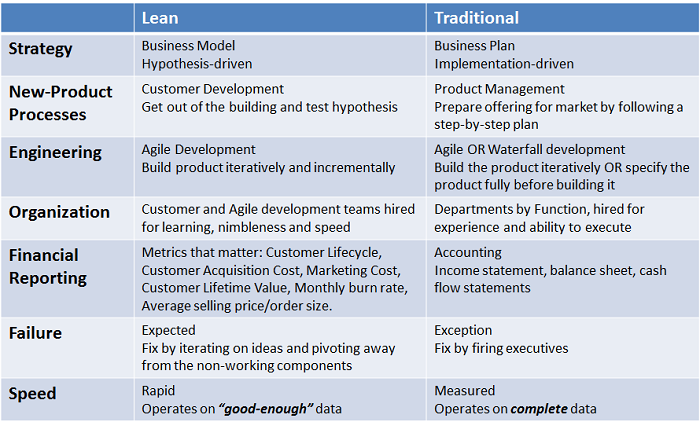With 19,000 startups in India as per the Economic Survey 2016, the importance of choosing the right business process for scale-up cannot be more emphasized. Here I am aiming to provide an overview of traditional and lean start-up models and conclude with a comparison of both of these processes.
Traditional Model
The traditional methodology resembled the waterfall model wherein the processes were linear as depicted in the below diagram.

The linear model starts with the idea/opportunity generation and flow through the different stages finalize the business plan, procure the needed funding, assemble the dream team, develop the product, introduce the product in market and finally evaluate success/failure.
The major disadvantage of this method is that there is no intermediate evaluation of the product’s relevance to the market and no validation of the initial assumptions till the product is introduced in the market. Any unexpected results in the market cannot be handled effectively as a major chunk of the raised finances is already consumed.
Hence, this model is more suited for a product that is already known and used in a financially viable market OR for established companies with validated and predictable business model.
With the passing of time; new, relevant and effective processes are replacing old business models. Lean Start-up method is being widely applied for start-ups.
Lean Start-up Method

Figure: Lean Start-up Method
- Rather than engaging in months of planning and research, entrepreneurs accept that all they have on day one is a series of untested hypotheses—basically, good guesses. It also involves deciding which business model to adopt for the product.
- Get out of the buildingapproach is also called customer development. This is used to test these hypotheses. Here, prospective customers’ views are collected on the product, customer requirements, pain points and desired pricing. The customers’ views are collected with only minimal talking by the marketing team. The customer is requested to express his views liberally and in detail.
- Based on the customer feedback, MVP (Minimum Viable Product)is developed. This version of the product includes only the key features identified in the previous phase.
- When the MVP is ready, product pricing is done. The decision of when to start charging the customer is entirely scenario based.
- After the pricing process, the product is introduced into the market with proper distribution channels and strategies for affordable customer acquisition.
- Pivoting is changing a fundamental part of the business model. It can be a simple pricing modification or a more complex action of re-packaging product; changing the sales channel OR target a different set of end users.
This cycle would repeat till the MVP is converted into a user-friendly final product.
There are many takeaways from this method
- Observe what is not working, Orient yourselves to the new facts, Decide which part of the business model needs change and Act decisively.
- Pivot quickly as it has a direct impact on the finances and success of the product.
- As customer feedback contributes majorly in the product development, Stealth Mode is declining in popularity.
- Emphasis on Brand Experience Over Brand Awareness
- Startup Metrics: Start-ups need metrics like Customer Lifecycle, Customer Acquisition Cost, Marketing Cost, Customer Lifetime Value, Monthly burn rate, Average selling price/order size. Using large company financial tools may result in frustration and confusion. Startups need metrics to evaluate whether the business model adapted is worth scaling into a company
Here is a summary as comparison of both the methods:

ABOUT THE AUTHOR
Madhu S. Sastry
Madhu has been with Mauverick for 5 years. She currently heads the technical documentation vertical.
Madhu has over 12+ years of experience in development and technical writing. She was earlier a part of Accenture and has worked on Unix shell scripting, Core Java and J2EE technologies with domain expertise in telecom and Cyber security.
